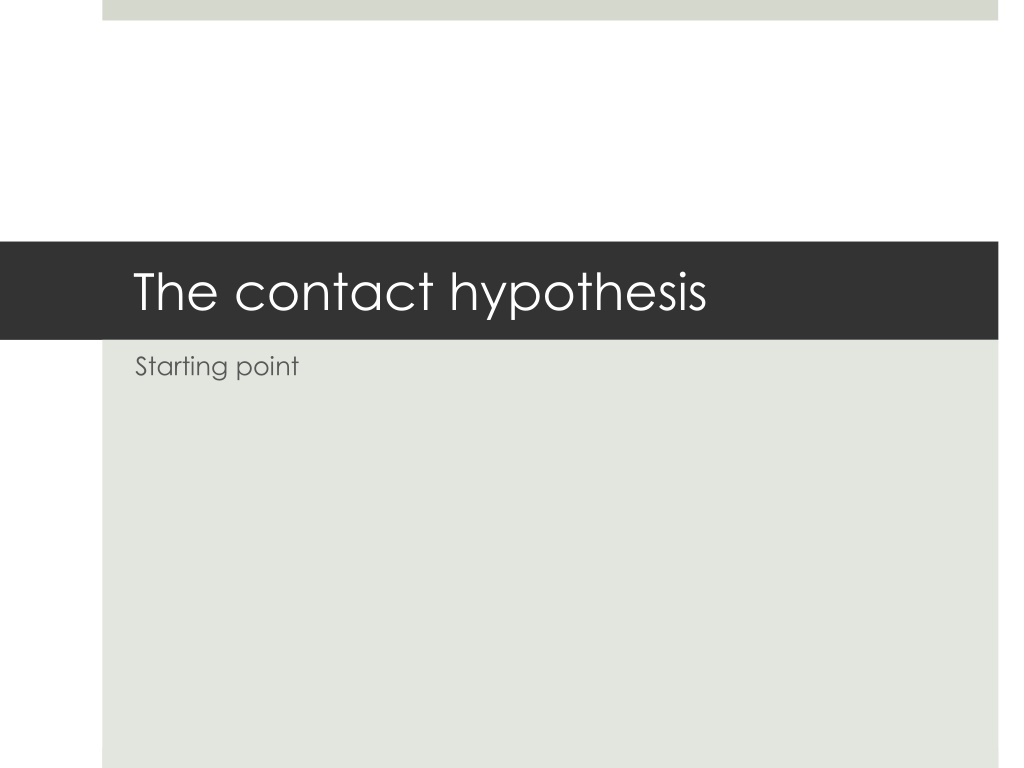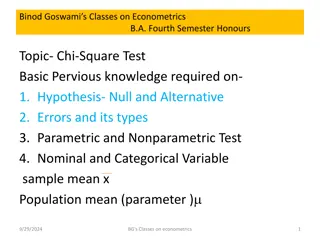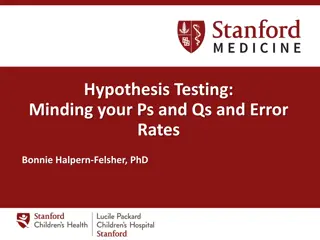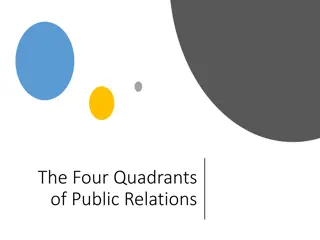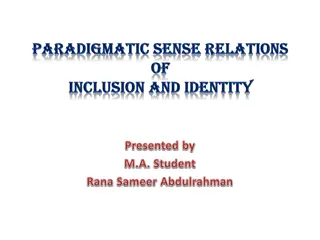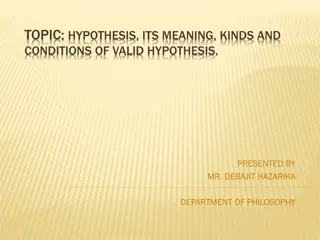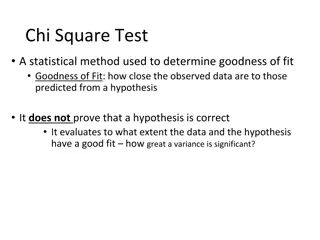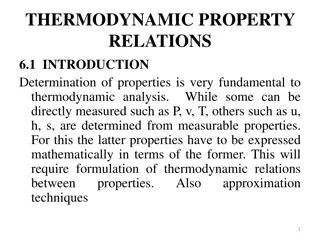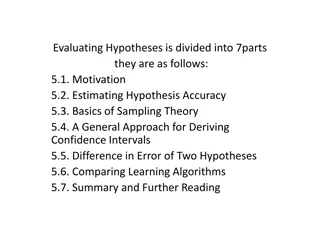Understanding the Contact Hypothesis in Inter-group Relations
The contact hypothesis explores inter-group relations from a cognitive perspective, highlighting how initial stereotypes and prejudices can be challenged and changed through positive interactions. It emphasizes the importance of contact in altering perceptions and reducing prejudice, as demonstrated by sociological studies. By engaging in inter-group interactions, individuals can gain more accurate impressions and revise their beliefs about different groups, leading to more positive attitudes and outcomes.
- Contact Hypothesis
- Inter-group Relations
- Cognitive Perspective
- Stereotype Reduction
- Prejudice Reduction
Download Presentation

Please find below an Image/Link to download the presentation.
The content on the website is provided AS IS for your information and personal use only. It may not be sold, licensed, or shared on other websites without obtaining consent from the author. Download presentation by click this link. If you encounter any issues during the download, it is possible that the publisher has removed the file from their server.
E N D
Presentation Transcript
The contact hypothesis Starting point
The Cognitive Perspective The traditional approach characterizes inter-group relations and intergroup perceptions as a process of autistic hostility (Newcomb, 1947)
The Cognitive Perspective That is, a self-amplifying cycle of antagonism, separation, and unrealistic negative attributions Inter-group hostility leads to avoidance which in turn leads both to more extreme negative perceptions and to an inability to test those perceptions against reality
The Cognitive Perspective The traditional approach claims that A) initial inter-group perceptions unrealistic Stereotypes and Prejudice are based upon erroneous beliefs
The Cognitive Perspective The traditional approach claims that B) inter-group interactions would end up providing individuals with accurate group perceptions Hence, our experiences in the the world would change our view of the word
The Cognitive Perspective The traditional approach claims that C) the inter-group relations would allow us to gather more accurate impressions of group members in the hic et nun Hence, we could revise our beliefs about that group (generalization)
The Cognitive Perspective How to change stereotypes and reduce prejudices A guideline
The Cognitive Perspective Sociological observations: Brophy (1946): After the US Merchant Marine began desegregating, the more voyages the White seamen took with Blacks, the more positive their racial attitudes became
The Cognitive Perspective Sociological observations: Kephart (1957): White police officers who worked with Black colleagues later objected less to having Blacks join their police districts, teaming with a Black partner, and taking orders from Black officers.
The Cognitive Perspective Precursory: Sociologists Williams (1947) The reduction of intergroup tensions He noted that intergroup contact would maximally reduce prejudice when the two groups share similar status, interests and when the situation fosters personal, intimate intergroup contact It constitutes an initial formulation of intergroup contact theory
The Cognitive Perspective Research tests the theory in field studies quasi experimental research Deutsch & Collins (1951) intimate contact- Two housing projects in Newark assigned Black and White residents to separate buildings Two comparable housing projects in NY City desegregated residents by making apartment assignments irrespectively of race
The Cognitive Perspective Deutsch & Collins (1951) The authors found that White women in the desegregated projects had far more optimal contact with their Black neighbors White women in the desegregated projects held their Black neighbors in higher esteem and expressed greater support for interracial housing (attitude change in the hic et nun setting)
The Cognitive Perspective Allport (1954) Introduced the most influential statement of intergroup contact theory in the Nature of Prejduice Allport s formulation stated that contact between groups under optimal conditions could effectively reduce inter- group prejudice
The Cognitive Perspective Allport (1954) Inter-group contact reduces prejudice when four features of the contact situation are present: Equal status between groups Common goals Intergroup cooperation Support of the authorities, law, or custom
The Cognitive Perspective Allport (1954) Allports formulation has been confirmed by different research, concerning different groups, different cultural context
The Cognitive Perspective Research that has stemmed from the initial formulation adds a variety of new variables that enhance the power of the inter-group contact in reducing prejudice (like a new recipe )
The Cognitive Perspective Just an example Shook & Fazio (2008) College students assigned to same-race and different- race room. Longitudinal test, between no-contact and contact condition
The Cognitive Perspective Shook & Fazio (2008) Explicit inter-group anxiety definition Implicit evaluative priming refresh
The Cognitive Perspective Explicit inter-group anxiety People often feel uncomfortable when interacting with others who belong to a different social group than they do. Intergroup anxiety is the term used to describe this discomfort. When interacting with members of a different social group (called an outgroup), people often anticipate a variety of negative outcomes, such as being taken advantage of or rejected. In extreme cases, they may be concerned that outgroup members will physically harm them .
The Cognitive Perspective Implicit evaluative priming
Priming valutativo Prime (Arabo) --> risposta valutativa Target (verme) --> risposta valutativa Se la risposta valutativa compatibile (incompatibile) con quella sollecitata dal prime, allora facilitazione (inibizione) della risposta al target
PP: AA vs EA FASE 1 Classificazione di parole 12 positive vs. 12 negative DV = RTs
Fase 2 Classificazione delle medesime parole Prime: foto AA vs foto EA Quindi ogni target era preceduto una volta da prime AA e da prime EA DV = RTs
Prime : reazione valutativa Target: reazione valutativa Relazione tra le due reazioni Congruente: speed up Incongruente: slow down
The Cognitive Perspective Just an example Shook & Fazio (2008) College students assigned to same-race and different- race room. Longitudinal test, between no-contact and contact condition
The Cognitive Perspective Shook & Fazio (2008) Explicit inter-group anxiety definition Implicit evaluative priming refresh
The Cognitive Perspective Shook & Fazio (2008) Inter-group contact reduces inter-group anxiety and implicit inter-group bias
The Cognitive Perspective Henry & Hardin (2006) EXP 1: White & Black // EXP 2: Christians & Muslism EXP 1. Feeling thermometer (feeling: very unfavorable vs. very favorable) Definition EXP 2. Warmth attiribution Definition
The Cognitive Perspective EXP 1. Feeling thermometer (feeling: very unfavorable vs. very favorable) A feeling thermometer, or a thermometer scale, is a procedure used in survey research to measure feeling. Respondents are given instructions to express their feelings in numbers using the thermometer for temperatures as a reference or an analogy. Positive feelings are labelled as warm feelings and negative feelings are equivalent to cold feelings. It aims to measure the direction of the attitude and also to assess the degree or intensity of the feeling (Alwin, 2007, p. 188).
The Cognitive Perspective Esempio: Qui di seguito troverai qualcosa che sembra un termomemtro. Vorremmo che tu usassi questo termometro per indicare il tuo atteggiamento nei confronti delle persone straniere. Se hai un atteggiamento favorevole nei confronti delle persone straniere, attribuirai un punteggio tra il valore 50 e 100 che dipende da quanto sei favorevole nei loro confronti. Se hai un atteggiamento sfavorevole nei confronti delle persone straniere, attribuirai un punteggio tra il valore 0 e 50 che dipende da quanto sei sfavorevole nei loro confronti. Le etichette associate ai gradi del termometro ti aiuteranno a indicare il tuo atteggiamento nei confronti delle persone straniere sul termometro. I valori intermedi, sebbene sprovvistiti di etichette, ti permetteranno di modulare la tua risposta. Sentiti libero di usare qualsiasi numero tra 0 e 100 . Ti chiediamo di essere il pi possibile sincero.
The Cognitive Perspective Henry & Hardin (2006) EXP 1: White & Black // EXP 2: Christians & Muslism EXP 1. Feeling thermometer (feeling: very unfavorable vs. very favorable) Definition EXP 2. Warmth attiribution Definition
The Cognitive Perspective Henry & Hardin (2006) The stronger is the contact, the lower is the intergroup bias, both on the feeling thermometer (EXP1) and on the warmth attribution (EXP 2).
The Cognitive Perspective Pettigrew & Tropp (2006) 515 individual studies 717 independent samples Combined 250.089 individuals From 38 nations
The Cognitive Perspective Effect size range from -.205 to -.214 Almost intermediate effect Intergroup contact generally relates negatively and significantly to prejudice The higher the contact, the lower the prejudice
The Cognitive Perspective Limits: Why does the intergroup contact reduce prejudices? Which is the process that leads inter-group contact to reduce prejudice?
The Cognitive Perspective Limits: Previous studies has measured very often inter-group contact. What happens when inter-group contact is manipulated? Which type of exemplars one should come across to change his/her prejudice?
The Cognitive Perspective Need for a cognitive model or inter-group model that can account for the observed effects (and null effects, see the effect size of the meta-analyses)
